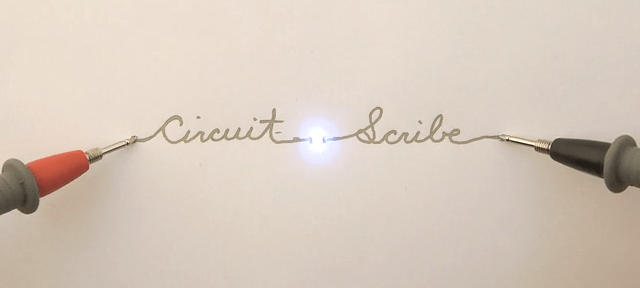After the super slick Ex1 circuit board 3D printer, say hello to Circuit Scribe: another Kickstarter project aiming to make it easier to prototype electronics by doing away with breadboards and soldering. But this project is taking a deliberately low-tech (and thus low cost) approach — by putting conductive silver ink inside a rollerball pen so you can doodle circuit designs on the back of an envelope.
As well as being conductive (achieving a conductivity of 50-100 milliohms per square per mil), the ink inside the Circuit Scribe pen is water-based and non-toxic, so it’s safe for kids to use in schools — one of the main targets for the project, along with makers, life hackers & artists.
The pen’s U.S.-based creators also claim it scribbles all over the pen-based conductive ink competition — with the ink in their prototype Circuit Scribe pens flowing smoothly from the rollerball as you write, with no need for shaking or squeezing, and no hanging around waiting for lumpy ink traces to dry and accidentally smudging your circuit with your elbow.
Circuit Scribe’s makers are also putting together a selection of components that can be used with the pen to build fully fledged circuits — including basic stuff like LED boards, coin batteries, 9V battery connectors; to more advanced components aimed at makers, such as a potentiometers, RGB LEDs and photo sensors; to a $100 developer kit containing additional components such as a motor, DIY solder boards, DPDT switches and more, for people who want to use the Circuit Scribe in conjunction with tinkering around with boards such as Arduino or Raspberry Pi.
Components can be connected to the conductive ink circuits you’ve drawn on paper by putting a magnetic material behind the paper — or putting it on a refrigerator door — and then snapping the components directly onto the circuit.
“You can build a circuit with nothing but a coin battery, paper clip, and LED, or build out complex circuits with multiple components,” the startup notes on their campaign page.
Unopened pens will have a shelf-life of about a year, while opened pens will “write smooth” for at least six months (provided you keep them capped and store away from heat sources and tip down when not in use). Each pen is good for 60-80m (262-328 ft) worth of lines, and the lines should keep their conductivity for “years”.
The startup is seeking $85,000 in crowdfunding to get Circuit Scribe to market. It’s already raised more than $22,000 with 40 days left to run. If the campaign hits its target, it’s aiming to ship the pens — and most of the component bundles — out to backers by June 2014.
